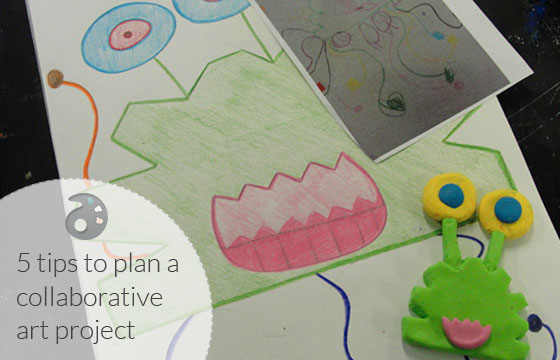Collaborating with another school on an art project can be one of the most fulfilling yet challenging projects you and your students will experience. Working on the project is the easy part. Getting started; trying to finding a school to work with or deciding on a lesson, can seem overwhelming. Here are five helpful tips, including a few proven lessons to get you started connecting classrooms.

1. Keep It Simple:
Working jointly and trying to communicate between school, especially across a large distances adds difficulty to a project. Overcomplicating things will only add frustration and may even result in the collaboration’s failure. The next four steps are designed to help you succeed by keeping it simple.
2. Finding a School:
You could collaborate with a school in another state or even another country but if this is your first time collaborating on a project you might want to start with a school that is right down the road. Send an email to the art teachers working in your district. Working closely eliminates some of the issues created by greater distances.
If you are feeling a little more adventurous, post a request to collaborate online. Art Ed 2.0 has a group dedicated to the topic. You might even consider posting a request as a comment to this article.
3. Go Digital:
Everything from discussing ideas to exchanging art work can be simplified by going digital. Though email works great for initial conversations, you might want to share a Google doc as a method for communicating the lesson plan. For exchanging art and displaying final work, you might consider using Dropbox.
4. Don’t Wait For An Idea
You don’t need to wait till you have a great project idea to get started. Collaboration should happen between the teachers as well as the students. Make a list of upcoming projects you plan to complete with your class. Present the list to your collaborating teacher. Something on your list might spark an idea for a joint project.
5. No Need To Reinvent The Wheel
For your first time collaborating, consider a project with a track record of success. Here are three project ideas to choose from.
Joint Sketchbook Assignment:
One of the easier ways to work together with another school is to both work on the same sketchbook project. As a possible first sketchbook assignment, consider the “no portrait self portrait”. Each student creates a work that represented themselves without actually drawing themselves. Though it’s not truly collaborative, its a good way to set up the exchange of ideas and images and also a great way to introduce the students to each other.
Perspective Room Drawings:
The concept behind this project is to have students draw a room using linear perspective based only on a written description sent by a student from the other school. Trying to draw a room that one has never seen based only on a written description is no easy task. Make sure the other school sends photos of their rooms. This way your students can compare their drawing to the photo once they have completed the assignment.
Example: Perspective Rooms

Monsters:
The basic concept for this joint project is a collaboration between an elementary class that draws monsters and a high school class that recreates the monsters in some way. The simplest method is to have the high school students redraw their version of the monsters. For a more advanced project, the high school students might create a 3D version in clay or soft materials, using the elementary school drawings as a reference. A quick Google search will reveal how this collaborative project has been recreated several different ways.
Examples: Monsters

What are some successful ways you have collaborated with another teacher?
Magazine articles and podcasts are opinions of professional education contributors and do not necessarily represent the position of the Art of Education University (AOEU) or its academic offerings. Contributors use terms in the way they are most often talked about in the scope of their educational experiences.




